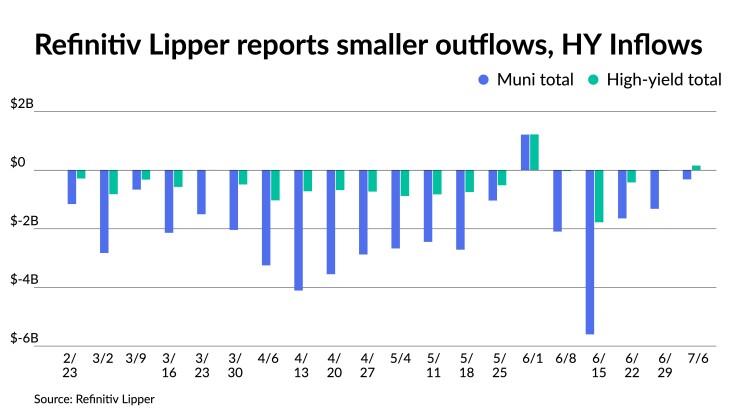Municipals were steady to firmer in secondary trading Thursday as a large airport revenue bond offering from the City and County of Denver, Colorado, and the Triborough Bridge and Tunnel Authority's MTA deal took the focus.
Municipals continued to ignore the movements of U.S. Treasuries, which saw yields rise for the second day, while equities rallied. Triple-A yields fell one to three basis points depending on the scale, with more strength inside 10 years.
As a result, muni-UST ratios fell again. They were at 67% in five years, 83% in 10 years and 94% in 30, according to Refinitiv MMD's 3 p.m. read. ICE Data Services had the five at 67%, the 10 at 85% and the 30 at 94% at a 4 p.m. read.
While only four sessions into July, all municipal indices are in the black to start the month with the overall index seeing positive returns at 1.11% with high-yield performing even better at 1.60%.

Investors pulled just $312.525 million from municipal bond mutual funds, per Refinitiv Lipper data, down from the $1.3 billion of outflows the week prior.Total outflows sit at $47.3 billion year-to-date.
High-yield saw $159.355 million of inflows after $15.443 million of outflows the week prior. Exchange-traded funds saw inflows to the tune of $515.478 million.
In the primary Thursday, BofA Securities priced for the City and County of Denver, Colorado, (Aa3/A+/AA-/) on behalf of its Department of Aviation $1.672 billion of airport system revenue bonds.
The first tranche, $1.490 billion of AMT bonds, Series 2022A, saw 5s of 11/2024 at 2.28%, 5s of 2027 at 2.77%, 5s of 2032 at 3.43%, 5s of 2037 at 3.74%, 5.5s of 2042 at 3.84%, 5s of 2047 at 4.10%, 4.125s of 2047 at 4.39%, 5.5s of 2053 at 4.08% and 4.125s of 2053 at 4.45%, callable 11/15/2032.
The second tranche, $180.605 million of non-AMT bonds, Series 2022B, saw 5s of 11/2026 at 2.08%, 5s of 2027 at 2.15%, 5s of 2032 at 2.77%, 5s of 2037 at 3.34%, 5s of 2042 at 3.62%, 5s of 2047 at 3.76% and 5.25s of 2053 at 3.78%, callable 11/15/2032.
Goldman Sachs & Co. priced and repriced for institutions
A very rough first half
“As expected, poor returns resulting from rates volatility-driven outflows” was the story of the first half of the year, said Morgan Stanley strategists Michael Zezas, Samantha Favis and Barbara Boakye in a midyear report.
In the second half of 2022, they said, “volatility and demand weakness could continue as an uncertain inflation path makes for uncertain Fed policy.” And
“Positive counterbalances should emerge to renew munis as a ‘late-cycle haven" in the next six to 12 months, with “curve inversion, improved comparison with corporates and rebounding demand,” indicating positive total and excess returns, according to Morgan Stanley strategists.
They expect further “UST yield curve inversion as the Fed balances inflation-fighting and early signs of slowing growth.” This, they said, “should benefit munis by limiting further negative returns, helping overall demand.”
Year-to-date, tax-exempt returns remain negative, noted Vikram Rai, head of Citi's Municipal Strategy group, though he noted they have improved somewhat as returns have risen from their lowest points of the year.
He doesn’t expect to see positive returns for munis, but if the rebound happens, it's likely an overall negative for the economy.
Munis “will need a very strong rally for that to happen, and it won't be a healthy rally because that rally will mean that we are in a recessionary scenario,” he said.
With a potential recession looming, muni credit quality may outperform corporate credit quality “based on lagged financial reporting [and] credit rating actions,” Morgan Stanley said.
But with the possibility of a recession, investor sentiment typically turns negative, Rai said. This could lead to greater outflow cycles as there are worries about credit.
While recessions have an impact on state and local government credit, with sales tax collections income tax collections dropping pretty quickly, the tax collections tend to become “sticky,” he said, as “local governments rely on property taxes.”
Even if an actual recession doesn’t manifest and tax collections are not impacted, recession-fueled fears and negative sentiment may deter retail buying, Rai said, adding it could offset the benefits of a rally.
Secondary trading
Maryland 5s of 2024 at 1.87%-1.82%. Harford County, Maryland, 5s of 2024 at 1.90%-1.85%. Georgia 5s of 2024 at 1.78%-1.76%.
California 5s of 2027 at 2.02%-2.00%. Washington 5s of 2030 at 2.48%-2.47%. Prince George's County, Maryland, 5s of 2030 at 2.48%-2.45% versus 2.71% on 6/29.
Montgomery County, Pennsylvania, 5s of 2031 at 2.51%-2.49% versus 2.80% original. Triborough Bridge & Tunnel Authority MTA bridges and tunnels 5s of 2032 at 2.76%. Maryland 5s of 2033 at 2.62% versus 2.64% Wednesday and 2.68% Tuesday.
New York City TFA 5s of 2035 at 3.13% versus 3.30%-3.29% Tuesday. New York City 5s of 2047 at 3.60%-3.56% versus 3.80%-3.79% Friday.
Los Angeles DWP 5s of 2052 at 3.33%. NYC waters 5s of 2052 at 3.66%-3.65%. Charleston, South Carolina, waters 5s of 2052 at 3.27% versus 3.52%-3.50% a week ago and 3.75% original.
AAA scales
Refinitiv MMD’s scale was bumped up to two basis points at the 3 p.m. read: the one-year at 1.48% (-2) and 1.81% (-2) in two years. The five-year at 2.05% (-2), the 10-year at 2.49% (-2) and the 30-year at 3.01% (unch).
The ICE municipal yield curve was bumped two to three basis points: 1.48% (-3) in 2023 and 1.80% (-2) in 2024. The five-year at 2.07% (-3), the 10-year was at 2.51% (-3) and the 30-year yield was at 3.02% (-3) near the close.
The IHS Markit municipal curve was bumped up to two basis points: 1.47% (unch) in 2023 and 1.81% (unch) in 2024. The five-year at 2.05% (-2), the 10-year was at 2.49% (-2) and the 30-year yield was at 3.01% (unch) at the close.
Bloomberg BVAL was firmer in spots: 1.50% (-1) in 2023 and 1.79% (unch) in 2024. The five-year at 2.08% (-1), the 10-year at 2.55% (-1) and the 30-year at 3.03% (+1) near the close.
Treasuries were weaker.
The two-year UST was yielding 3.029% (+2), the three-year was at 3.052% (+4), the five-year at 3.046% (+7), the seven-year 3.073% (+7), the 10-year yielding 3.005% (+8), the 20-year at 3.457% (+5) and the 30-year Treasury was yielding 3.191% (+7) at the close.
FOMC minute reactions
U.S. markets got little comfort but more clarity from the Federal Open Market Committee minutes overnight, said Jeffrey Halley, a senior market analyst at OANDA.
“It was clear from the minutes that the committee members remained highly focused on culling inflation, even if it was at the expense of a sharp economic slowdown,” he said.
For July’s meeting, a half or three-quarter rate hike is most likely, most analysts say.
“The minutes touched on the need for credibility and as such, I believe there will be no wimp-out by the FOMC at the end of this month, as that would achieve exactly the opposite plus interest,” Halley said.
That was enough to shift the “U.S. yield curve higher although most of the gains were concentrated in the two-year tenor which closed back at 3.0% overnight,” he said.
Market participants still expect a recession, and “that sentiment will only increase if the inversion across the 2s/5s/10s part of the curve increases,” Halley said.
The June FOMC meeting minutes “framed the Fed’s decision to hike rates by 75 [basis points] in June as motivated by a sharp and broad-based increase in May’s Consumer Price Index and the risk that inflation expectations become unanchored,” said Mickey Levy, chief economist for Americas and Asia at Berenberg Capital Markets.
A key theme reiterated in the minutes was “the need to return inflation to the Fed’s 2% objective to ‘creat[e] conditions conducive to a sustainably strong labor market over time.’ ”
Levy said he believes “that in the face of slowing economic growth and deteriorating labor market conditions, the Fed will likely pause its rate hikes and move to ease policy while referencing the need to remain balanced in pursuit of its dual mandate.”
Market expectations of a policy pivot “are reflected in the 60 [basis point] decline in two-year Treasury yields from their mid-June peak, with Fed funds futures markets now pricing in rate cuts as soon as mid-2023,” according to Levy.
The June minutes reveal Fed members are likely to consider a rate hike of either 50 or 75 basis points at the July meeting, though “a raft of FOMC members in the weeks following the June meeting have publicly thrown their weight behind a 75 basis point rate hike,” he said.
Levy noted the Fed is leaning toward a three-quarter point rate hike in next month, but “considering recent economic data, and an anticipated slowing in m/m headline inflation beginning in July, the Fed … could turn on a dime and opt for a more conservative 50 bp hike.”
Mutual fund details
In the week ended July 6, Refinitiv Lipper reported $312.525 million of outflows Thursday, following an outflow of $1.317 billion the previous week.
Exchange-traded muni funds reported inflows of $515.478 million after inflows of $476.424 million of inflows in the previous week. Ex-ETFs, muni funds saw outflows of $828 million after $1.793 billion of outflows in the prior week.
The four-week moving average was at negative $2.219 billion from negative $2.664 billion in the previous week.
Long-term muni bond funds had outflows of $84.718 million in the last week after outflows of $901.784 million in the previous week. Intermediate-term funds had outflows of $209.674 million after $370.155 million of outflows in the prior week.
National funds had outflows of $251.902 million after $1.057 billion of outflows the previous week while high-yield muni funds reported $159.355 million of inflows after $15.443 million of outflows the week prior.





